Ginger is popular for its unique taste and aroma. The vegetable is grown for their rhizomes to use for cooking. Ginger is also used for various medications and health benefits. You can also witness different shapes and colors of flowers.
Plant ginger in well-drained fertile soil under filtered sunlight, fertilize and water them regularly in the growing season, protect them from cold, and harvest them after 8-10 months. The plant will encounter issues like discolored leaves, curly leaves, pests, diseases, etc.
Growing ginger at home is exciting and rewarding. This guide will take you through every detail about ginger, the problems they may face, and the ways to encounter them.
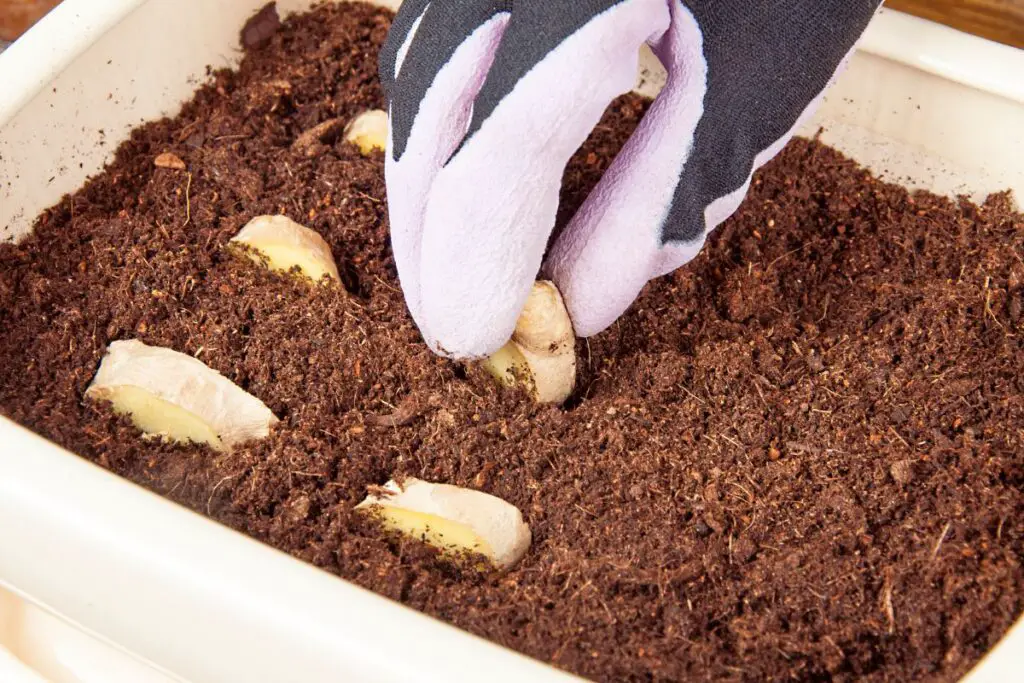
Ginger: An Overview
Ginger is a herbaceous perennial flowering plant grown for the ginger rhizomes or ginger roots.
These rhizomes are used for cooking and medicinal purposes.
For several years, ginger has remained permanently in every kitchen worldwide.
The rhizomes come in awkward shapes and sizes.
Divide or cut the rhizomes into pieces and make a shape where the pieces can be comfortably peeled and cut into further pieces.
Ginger varieties
Gingers have a lot of varieties, and these varieties have a lot of cultivars.
Let’s have a look at some:
Chinese ginger
These are the common gingers found in all grocery stores.
The cultivars under this variety are:
- Nadia
- Ganzhou
- Guangzhou
- Rio de Janeiro
- Shandong Laiwu
Don’t worry if it’s normal common ginger.
You can cut and replant them to get more of them in your garden.
Japanese ginger
These gingers are a bit smaller than the common ginger rhizomes.
But, they have more flavor than the common ones.
Some cultivars are:
- Kintoki
- Sunti
- Oshoga
- Sanshu
Various other ornamental gingers produce colorful aromatic flowers with rhizomes that add extra depth and drama to your garden.
But the common ginger produces only leaves and rhizomes.
Other varieties include:
- Shampoo ginger
- Peacock ginger
- Yellow ginger
- White ginger
- Spring ginger
Ginger benefits
Ginger can help us in a lot of ways.
They are beneficial not only in enhancing the taste of dishes but also for health.
Here is a list of ginger benefits:
- Ginger roots treat nausea and stomach upsets.
- It works as a brilliant anti-inflammatory for pain, swelling, and inflammation.
- Ginger helps to reduce weight and boost metabolism.
- Ginger helps treat cough and cold and other winter blues.
- Ginger tea gives us relief from headaches.
- It also reduces heart diseases and other illnesses like blood clots.
- Ginger roots prevent diabetes.
When, where, and how to plant ginger?
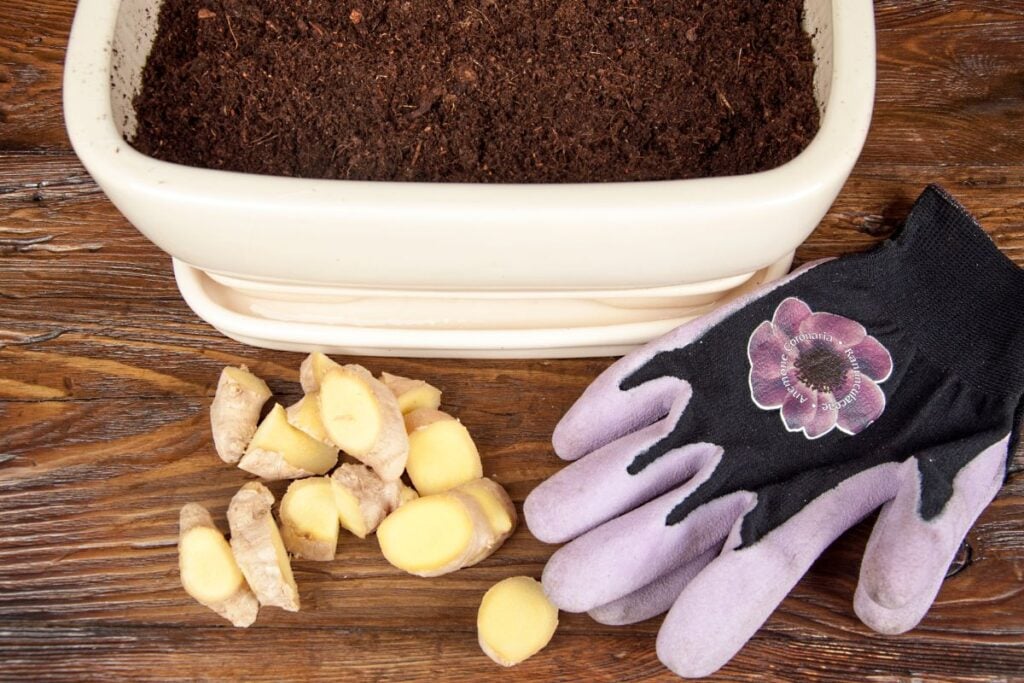
The care for ginger starts before you plant them.
So, knowing the time, place, and planting method are essential.
It allows ginger plants to grow vigorously throughout the growing season, i.e., spring and summer.
When to plant ginger?
Gingers grow best when planted in the early spring.
Once the temperature rises above 75°F, ginger will flourish.
You will receive healthy big rhizomes.
You can also plant gingers in the late winter or early summer.
Ensure that the soil temperature remains around 75°F at the planting time.
It encourages fast sprouting and development.
You can plant ginger a little late if you live in hotter climates.
Since the weather will be almost warm throughout the year, ginger will stay fine, and you can harvest them later if they mature late.
You have to protect them in winters.
But, in colder zones, don’t be late in planting ginger.
It is because gingers are cold-tender and must be harvested before the frost arrives.
Otherwise, your rhizomes may rot and die in the cold.
Also read: When To Plant Ginger Roots?
Where to plant ginger?
The best place to plant ginger is a location with filtered or dappled sunlight or partial shade.
Gingers hate sunny locations.
Direct sunlight dried out the rhizomes, which are useless to us.
The northern or eastern direction of your garden would be the best location for ginger.
South and west are the worst because they get maximum sunlight.
Keep reading to find out how you can adjust lights for ginger plants.
Along with the light, make sure the location has well-drained fertile soil.
If not, you must amend it by adding compost.
Read on to know more about the soil.
Looking for gardening supplies? We have tested 100's of products before recommending them to you guys. Check out our best pick below:
| Image | Gardening Supplies | Best Price? |
|---|---|---|
 Top
Top Top
Top | Raised Garden Bed Kit | Check On Amazon |
 | XLUX Soil Moisture Meter, Plant Water Monitor, Soil Hygrometer Sensor for Gardening, Farming, Indoor and Outdoor Plants, No Batteries Required | No Results |
 Top
Top Top
Top | 82 Pcs Garden Tools Set and Extra Succulent Tools Set | Check On Amazon |
 | Joeys Garden Expandable Garden Hose with 8 Function Hose Nozzle, Lightweight Anti-Kink Flexible Garden Hoses, Extra Strength Fabric with Double Latex Core, (50 FT, Black) | No Results |
 Top
Top Top
Top | Dual Chamber Compost Tumbler | Check On Amazon |
 Top
Top Top
Top | Sunnyglade Plant Stakes | Check On Amazon |
 Top
Top Top
Top | Organic Cold Pressed Neem Seed Oil | Check On Amazon |
 Top
Top Top
Top | Mighty Mint Gallon :-Insect and Pest Control Peppermint Oil | Check On Amazon |
 Top
Top Top
Top | Scotts DiseaseEx Lawn Fungicide | Check On Amazon |
 Top
Top Top
Top | Jacks Classic 20-20-20 All Purpose Fertilizer | Check On Amazon |
 Top
Top Top
Top | 30,000 Seeds Pollinator Attracting Wildflower Mixture | Check On Amazon |
 Top
Top Top
Top | Survival Vegetable Seeds Garden Kit-Over 16,000 Seeds | Check On Amazon |
How to plant ginger?
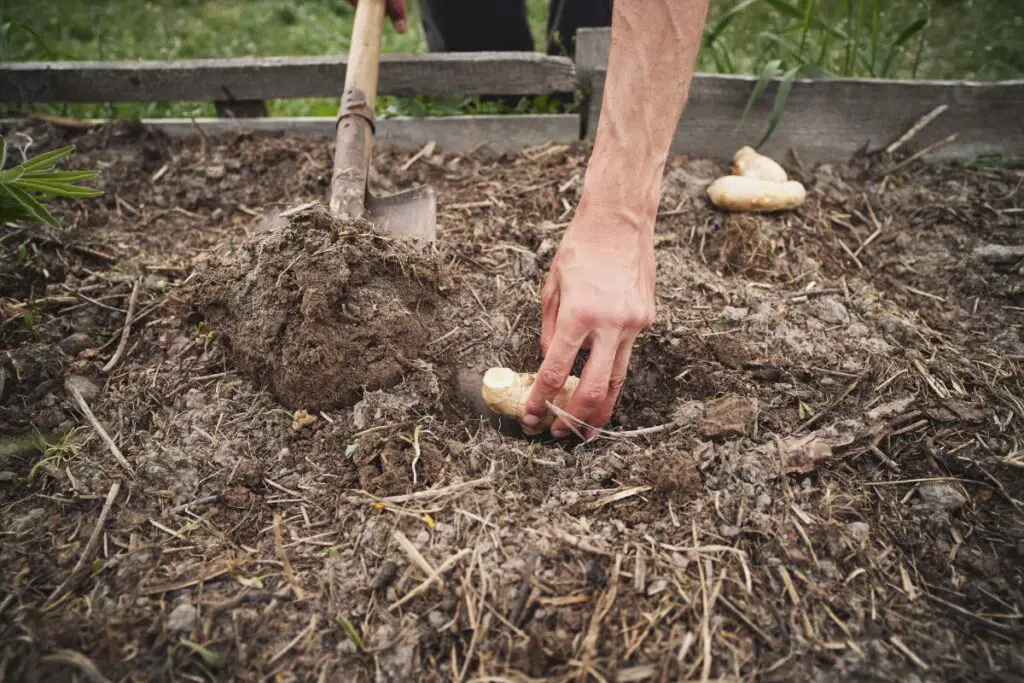
Planting ginger is very easy.
First, separate the rhizomes or cut them into pieces around 1-2 inches each.
Prepare the soil bed as per ginger’s need and plant them about 2-4 inches and 6-8 inches apart.
Remember that the depth and distance at the planting time are very important.
Planting them too deep will make the rhizomes difficult to sprout.
At the same time, planting them too shallow exposes the rhizomes to sunlight and dries them out.
Though gingers don’t require a lot of space and don’t create any trouble if planted too close, extreme close can affect rhizome size.
Besides, if you don’t want to harvest the whole plant, the leftover rhizomes will require space to grow freely. So, space is important.
After planting, water them thoroughly and fertilize them throughout the growing seasons.
Also read: How Far Apart Should Ginger Be Planted?
Ginger care guide
Now, let’s jump into the care guide in detail.
Light requirements
Gingers grow best under filtered or dappled sunlight or partial sunlight.
Gingers cannot withstand direct sunlight.
Some bad effects of direct sunlight are:
- The leaves become brown due to sunburns
- The leaves become dry and papery.
- The rhizomes dry up and die.
- The plant wilts and dies.
However, ginger can tolerate at least 2-5 hours of direct sunlight daily.
It keeps them healthy and also encourages flowering.
Give gingers 2-5 hours of direct sun if you want flowers.
Direct sunlight in the early morning is the best because it is mild, less intense, and perfect for gingers.
If you care about the rhizomes only, grow ginger in partial shade or filtered sunlight throughout the day.
If your ginger plants get too much light, fix shading nets.
Or, plant ginger under tall trees or near walls or buildings for shade.
Some companions that can give ginger shade are fruit trees, cilantro, peppers, etc.
Also read: How Much Light Does A Ginger Plant Need?
Water requirements
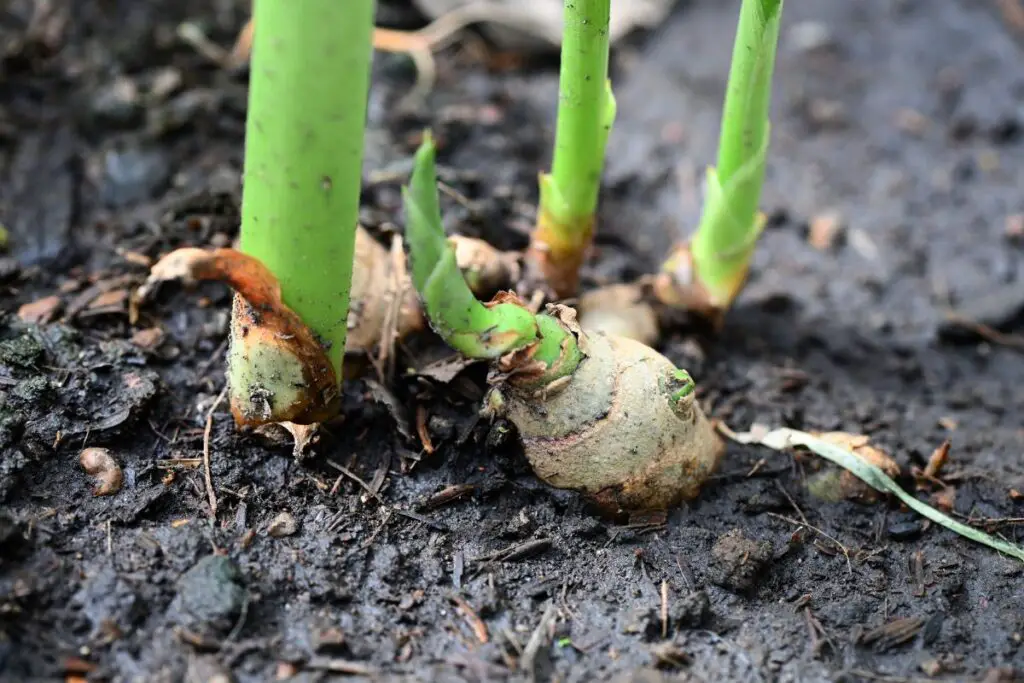
When you cut open ginger, it is quite moist.
So, it is an indication that gingers love and require plenty of moisture.
Keep the soil consistently moist but don’t create a pool around the soil or roots.
Water the plant regularly 1-2 times per week.
Before the next watering, check the dryness of the soil surface.
Never let the whole soil dry, but only the top 1 inch.
This rule maintains the soil moisture and saves your plant from overwatering.
In the winters, avoid watering the plant.
Since the rhizomes will stay dormant, they won’t consume any moisture.
When the plant is ready for harvest, stop watering 2-3 weeks before you plan to pick the rhizomes up.
Also read: How To Water Ginger Plant?
Soil requirements
Gingers grow best in soil that supports good drainage, retains the required moisture, and makes the soil nutritious for the plant.
The best type of soil for ginger is loamy soil.
It contains equal amounts of sand and silt with some clay.
To improve the soil quality, you can add compost.
It improves drainage, retention, and fertility, thus making gingers thrive in the long run.
Make sure that the pH level of the ginger soil remains within 5.5-6.5.
If it is high, add unused coffee grounds to correct it.
If the level is low, add calcium carbonate or dolomite to neutralize.
For better results, solarize your soil bed for 40 days before planting.
It eliminates insects and pathogens from the soil and supports healthy ginger growth.
Also read: What Type Of Soil Does Ginger Grow In?
Fertilizer requirements
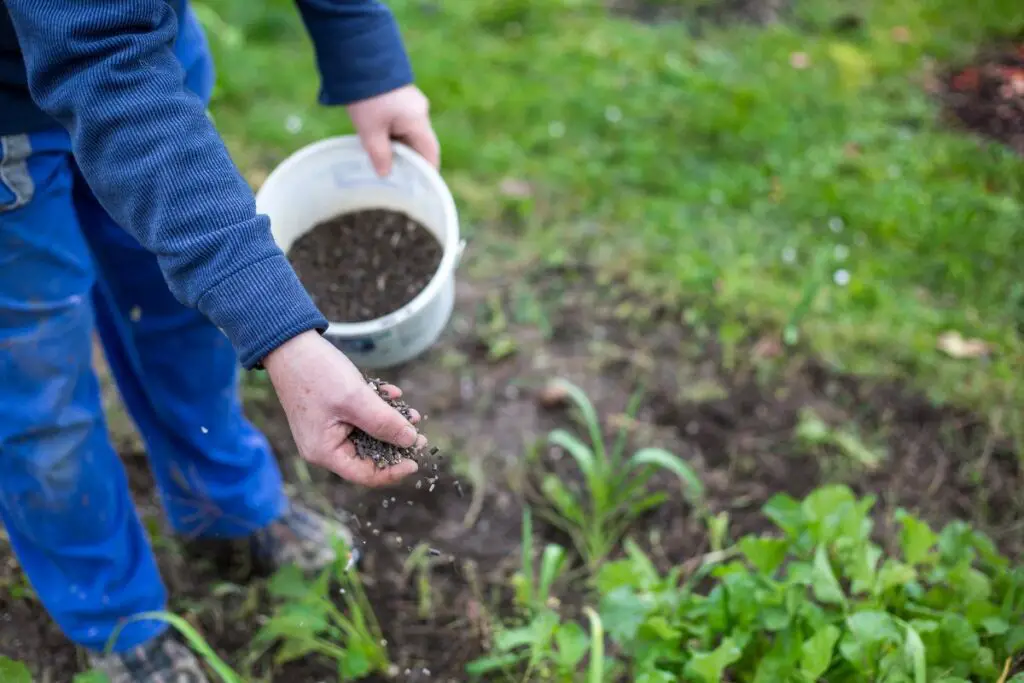
Ginger plants love to receive nutrients like nitrogen, phosphorus, potassium, calcium, magnesium, iron, manganese, etc.
Altogether, they help ginger to grow and develop well and stay fine for a very long time.
Before you plant ginger plants, add slow-release fertilizer or compost to increase fertility.
When new shoots appear, fertilize gingers with a liquid fertilizer having a 10-20-20 NPK value.
Go easy on nitrogen because too much nitrogen makes the plant concentrate on leaves rather than the rhizomes.
Stop fertilizing when the plant flowers and use some potassium to encourage flowering more.
There are many options for fertilizers.
As a slow-release, you can use chicken or cow manure 2-3 times per year.
You can also try fish emulsion or seaweed every 6-8 weeks.
Also read: How To Fertilize Ginger?
Temperature requirements
Ginger plants belong to the tropical and subtropical areas and thus require warm temperatures to develop at their best.
The ideal temperature supporting vigorous ginger growth ranges between 75-85°F or above.
The soil temperature should be around 75-77°F.
Gingers rarely get affected by the hot weather until it isn’t very dry.
If the weather is dry, manage it by watering the plant more often.
Temperature below 50-60°F, and your ginger plants will need protection.
The rhizomes go dormant in winter because they store energy and use it in the next season.
They need to be protected and should not be allowed to sprout.
You don’t have to shift ginger indoors if you live in hotter zones.
Reduce watering, stop fertilizing, and add mulch to protect the roots and trap the moisture.
In colder zones, grow ginger in pots to shift them inside in winters.
Grow some cold hardies like Japanese or Thai.
If they are in the ground, harvest the rhizomes before winter.
Or, pick and store the rhizomes in a dark, dry, and cool place to prevent sprouting. Replant them in the next year.
Try all possible ways to protect the plant and the rhizomes’ energy preservation techniques.
Also read: Ginger Plant Temperature Tolerance
Humidity
Gingers are tropical plants.
They need high humidity to survive, around 70-90%.
Low humidity levels can dry up the rhizomes, affect their development, and kill them.
Humidity problems are more on the inside than the outside.
But if the outside humidity drops for any cause, try the following:
- Keep water trays around the plants. As the moisture evaporates, it adds extra humidity to the air.
- Mist the plants regularly.
- Mulch the ginger beds to trap the moisture and prevent it from evaporating.
- Use pebble trays if your plant is in pots.
You can also try these methods indoors.
Besides, you can add humidifiers to create the exact humidity inside.
Harvesting ginger
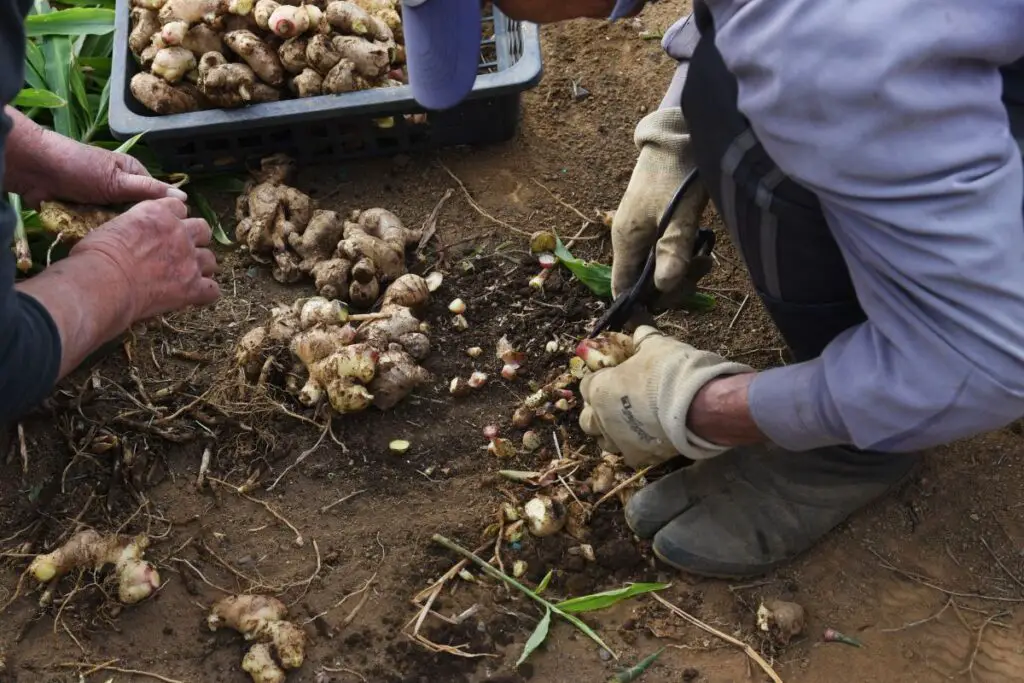
Gingers get ready for harvest 8-10 months after planting.
Suppose you plant ginger in the early spring, then harvest it in the fall.
It is better to harvest before winter as it saves the rhizomes from cold injury.
If you keep them in the ground, the rhizomes will receive frosty weather and rot.
So, don’t be too late to harvest gingers, especially if you live in colder climates.
If you are from the hotter zones and want to harvest them late, you can keep them in the ground even in winters.
Apply a layer of mulch so that the rhizomes don’t get the cold weather.
There are several ways to harvest:
- You can harvest 4 months after planting. In that case, you will get young or green ginger.
- For mature and tasty ginger, harvest them after 8-10 months.
- You can harvest the whole plant by collecting all the rhizomes and replanting them again next year.
- You can harvest only a few rhizomes. Cut off some rhizomes and leave the rest in the ground. The ginger will sprout again from the cut portion. In that case, you don’t have to replant the rhizomes again.
You can try all methods as per your need and wish.
After harvesting, wash the rhizomes with warm water and clean with a brush to remove the dirt.
Since gingers have awkward shapes, be careful and try cleaning every corner.
If the dirt remains, let the rhizomes dry for some time.
Start cleaning after some time in the same way.
Also read: When Is Ginger Ready To Harvest? (+How To)
Storing ginger
You can store ginger rhizomes for many days.
Here are some effective ways to store gingers:
- Peel the skin of the rhizomes and store them in the refrigerator. Use them within 2-3 weeks.
- Cut the rhizomes, don’t peel, and freeze and store them for 2-3 months.
- Make a paste of ginger and use it for cooking purposes.
- Make a powder from the rhizomes and store them for tea or cooking. You can store the powder for a very long time.
Ginger problems
Now that we are done with the care guide let’s talk about some basic problems ginger may face while growing.
Curly leaves
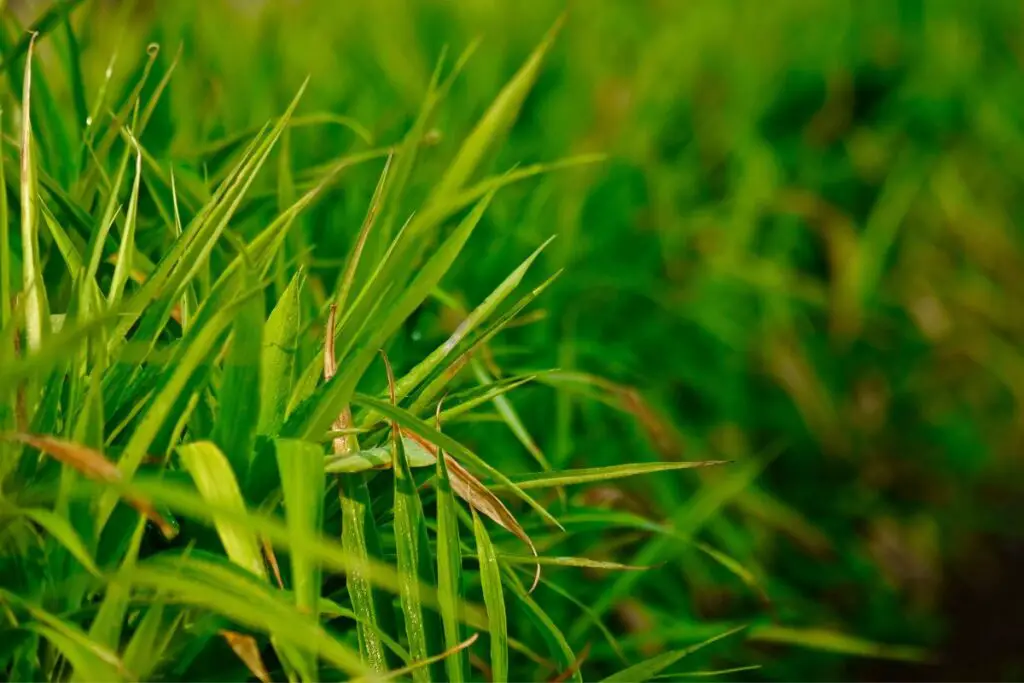
The only reason behind ginger leaves curling is bacterial wilt or green wilt.
It is a disease caused by pathogens in the soil from previously planted crops.
The disease is irreversible.
If any of your ginger plants have the disease, the best option is to discard the plant and consider crop rotation.
The signs of this disease are:
- Curling and rolling leaves
- Over time, the leaves become yellow or brown
- The leaves also get wilted.
- The plant becomes stunted.
- When you cut open a stem, a slimy liquid will ooze out.
To prevent this disease, perform crop rotation every 1-2 years.
Avoid overwatering your plant in such conditions.
Grow them in raised beds or hills if needed.
Before planting, solarize the soil for 40 days under the full sun to kill the bugs and pathogens.
Plant some mint or lemongrass, and then plow the soil.
The essential oils released from the plants can kill the pathogens in the soil.
Also read: Ginger Plant Problems (Yellow, Brown, Diseases & More)
Yellow leaves
The reasons are bacterial wilt, fusarium yellow, dry rot, rhizome rot, aphids, and white grubs.
Another reason behind yellow leaves and stems is that gingers are ready for harvest.
When the leaves become yellow and die, followed by flower deaths, ginger rhizomes are ready to get picked.
There is no treatment for bacterial wilt, fusarium yellow, and dry rot.
Discard the infected plants soon.
Then, shift the healthy plants somewhere else.
In the case of rhizome rot, remove the infected parts of the leaves, apply some fungicide, and stop watering.
But, if the rhizomes have rotted extremely, there is no chance of saving them.
Pests like aphids suck the sap and moisture and turn the leaves yellow.
White grubs feed on the rhizomes and create holes in them.
Over time, the leaves become yellow.
To remove pests, spray Neem oil or vegetable fungicides.
Add some repellents like maize, onion, sorghum, mint, etc.
Other reasons are overwatering and underwatering.
You must keep the soil moist consistently but shouldn’t make gingers stand over a pool of water.
Brown leaves
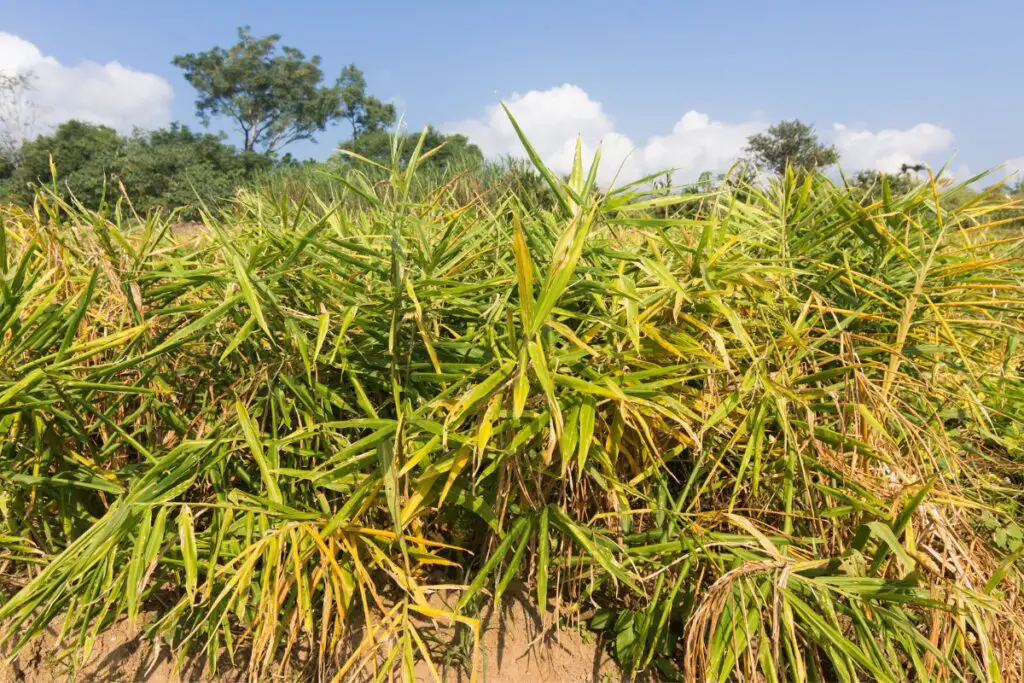
Gingers turn brown due to diseases or problems like excessive light, lack of moisture, improper fertilization, or dormancy.
Diseases like bacterial wilt, ginger leaf blight, and fusarium yellow make the leaves yellow or brown.
To prevent it, consider crop rotation and destroy the infected leaves immediately.
Ensure gingers are not exposed to excessive sunlight.
Otherwise, the leaves will get burnt, and the plant will wilt and die.
Always maintain around 60% moisture levels.
Water the plant regularly, allowing the top inch to dry.
Maintain 70-90% humidity around them.
Fertilize them every month with liquid fertilizers throughout the growing season.
At the same time, don’t use too much.
Apply liquid fertilizer (NPK 10-20-20) only once a month.
Use well-rotted manure 2-3 times per year in the growing seasons.
Don’t use fresh manure as that will burn the plant.
Apply fish emulsion or seaweed only every 6-8 weeks.
Gingers become dormant due to lack of moisture and in winters.
These two are the times when ginger leaves become brown.
In winter, the leaves become brown, and then the plant dies.
Don’t worry, as the rhizomes underground are alive.
The plant will start growing again when the weather warms up.
No growth
The common reasons are lack of moisture and nutrients, poor soil, weed growth, pests, and diseases.
Never keep the gingers dry for a very long time.
Always maintain consistently moist soil and 70-90% humidity levels.
Use well-drained fertile soil. Since soil is a plant’s home, a bad home leads to bad plant growth.
The best type of soil is loamy soil.
Add compost to amend the soil and improve drainage, retention, and fertility.
Weeds absorb all the moisture and nutrients and make gingers suffer for the same.
So, getting rid of them is very important.
Mulch your soil bed to suppress weed growth.
Grow leafy green ground covers like spinach or kale to suppress the growth.
To remove pests, use Neem oil or Imidacloprid.
To prevent it, solarize your soil before planting or have some lemongrass and mint as companions.
Diseases that can stop the plant from developing are bacterial wilt, fusarium yellow, dry rot, and rhizome rot.
To control diseases, avoid overwatering, consider crop rotation, soil sanitization, and soil solarization.
Have companions like mint or lemongrass, and keep the surrounding clean and tidy.
Also read: Why Is My Ginger Plant Not Growing? (6 Causes+Fix)
No flowers
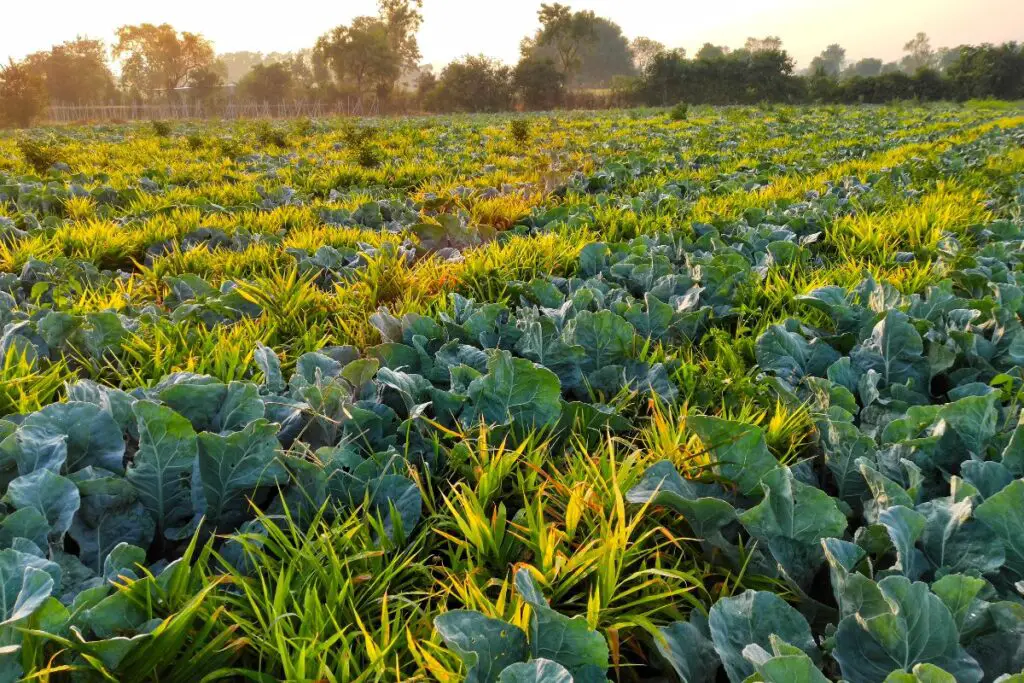
The main reason behind this problem is the lack of direct sunlight.
Ginger hates direct sunlight, but 2-5 hours of direct sunlight is fine.
The best is the morning sun before 11 am.
It is less intense and perfect for gingers.
Some hours of direct sunlight encourage ginger to produce flowers.
Let gingers have 2-5 hours of morning sun if you want flowers.
Other reasons are lack of moisture, fertilizer, and low temperatures.
Give gingers enough moisture and adequate fertilization, and protect them from low temperatures.
Try to keep them warm.
Some gingers need time to become mature and flower.
In colder zones, ginger matures late. So, in that case, you have to wait until maturity.
Also read: Why Is My Ginger Plant Not Flowering? (8 Causes+Fix)
Dying ginger
The reasons are improper watering, too much direct sun, poor fertilization, cold temperature, lack of humidity, pests, and diseases.
As I said multiple times, ginger loves moisture.
So, you must water them regularly and maintain high humidity.
Keep them away from the direct sunlight, especially the afternoon sun.
Fertilize gingers in time to keep them growing and encourage flowering.
Protect the ginger rhizomes from cold weather.
Bring them inside if you live in colder zones.
If you are from hotter zones, keep them outside with a thick layer of mulch.
Water rarely and does not fertilize the plant in winter.
If the problem is pests and diseases, identify which bug or disease is destroying your plant and take immediate action to reverse and fix the problem.
One easy way to fix infestation is by using Neem oil.
Whenever you find any issues, spray some neem oil.
It is safe to use.
If the infestation has just started, Neem oil should repel it and prevent it from spreading.
Also read: Why Is My Ginger Plant Dying? (7 Causes+How To Fix)
Pests and Diseases
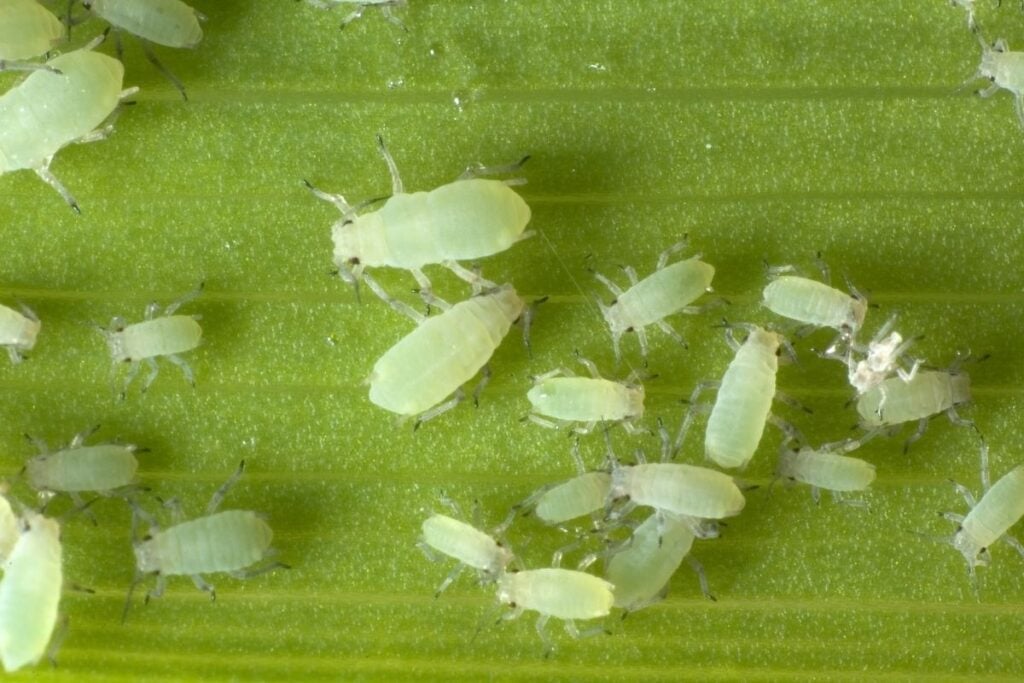
Pest and disease infestation is responsible for some problems shared above.
Here, we will share the most common pests and diseases and how to deal with them.
There might be some reparations and some new information.
So, let’s have a look.
Common ginger pests
Though there are lots of pests around, below is a list of some common ginger bugs:
Ginger Maggots
These bugs are moths’ pupae that damage the rhizomes during storage.
The larvae have pale, whitish bodies and blackheads.
The larvae enter the rhizomes when stored in dark and moist areas with temperatures ranging between 39-95°F.
The rhizomes have holes, and they rot due to maggot excretions.
To control the infestation:
- Keep the areas of storage neat and clean.
- Store the healthy gingers and discard the bad ones.
- The place of storage should be dark, dry, and cool.
Chinese Rose Beetles
These reddish brown bugs feed on the leaves.
They are nocturnal and feed at night.
So, you may see your ginger leaves to be fine today but small holes the next day.
After eating the leaves, they leave behind only the veins and shredded outlines.
It seems as if the leaves were skeletonized.
Due to this, the plant’s photosynthesis gets badly affected.
The plant begins to stop growing and ultimately dies.
To control the infestation:
- After the sun sets, switch on bright lights in your ginger beds for 2-3 hours to stop the bugs from coming towards your ginger and feeding on them.
- Cover the plant with floating row covers at night to reduce bugs’ access to the ginger plants.
- Disturbing the soil can destroy the eggs and larvae.
Slugs
Slugs are irritating bugs found in all places, especially in moist areas.
Though they are conscious about their diet, hunger inspires them to feed on ginger.
Slugs feed on the leaves and mature leaf midribs and leaves behind sticky and shiny trails of their movement.
Slugs hide inside the cracks of the soil and come out at night to feed.
The leaves and the rhizomes have several eaten holes, which further affects plant and rhizome development.
To eliminate the slugs:
- Pick them up if the infestation is small. Do it early in the morning or at night.
- Release natural predators like birds, toads, or snakes.
- Set traps like vinegar or beer to attract them. Put the cans inside the soil, keeping 1 inch outside the soil. The scent will attract the slugs, move towards the cans, and drown and die.
- Spread diatomaceous earth all around the ginger plants. It will dry and kill the pests.
- Mulch your soil bed to snatch the shelter of slugs.
- Keep the surroundings neat and clean so that the slugs don’t get space to hide.
Thrips
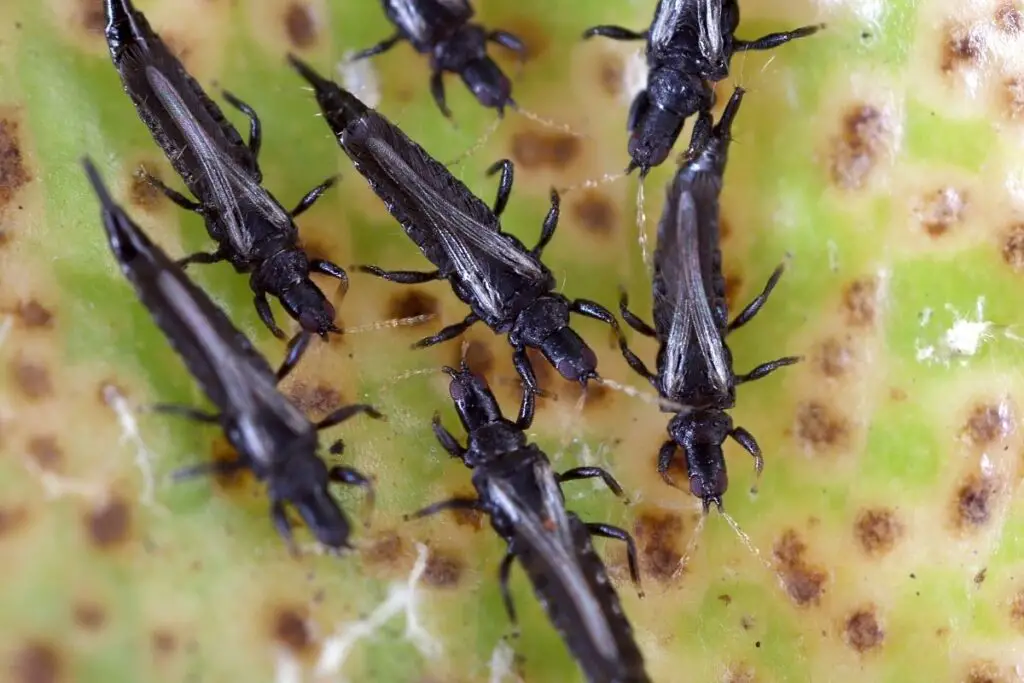
These pests are 1-1.3mm long and feed on the leaves and rhizomes.
The environment that encourages thrip infestation is high humidity and temperatures around 75-85°F.
Female thrips create slits in the leaves and lay eggs on them.
The adults and nymphs suck the cell sap and damage the plant from inside.
Due to the loss of sap, the plant becomes malnourished and deformed.
Some symptoms are:
- Pale leaves with white spots
- Leaves scorching and drying
To get rid of the thrips:
- Remove the debris from around the plant and destroy the bugs.
- Terminate or suppress the weed growth around the plant bed.
- Use 50% dichlorvos or 40% dimethoate over infected plants.
- Release natural predators like Roberfly, Phytoseiid mites, flower bugs, etc.
Aphids
Aphids are present everywhere.
So, your ginger plants are bound to get these bugs if conditions are made favorable.
The ideal condition is prolonged wetness.
Once aphids invade your plant, they feed on the plant sap and make the leaves yellow, deformed, and twisted.
The insects have very tiny and difficult to spot.
Once the infestation increases, it is challenging to control their population.
The symptoms of aphid infestation are:
- Yellow leaves
- Stunted growth
- Small rhizomes and poor quality
- Distortions
The ways to control aphids are as follows:
- Spray neem oil in the first place.
- Release natural predators like ladybugs and lacewings.
- Water the plant with force to dislodge and disturb its population.
- Use other insecticides to deter them.
- Try using Imidacloprid. The plant will absorb the chemical. When the aphids try to suck the sap, they will consume the chemical and die. Consult the seller before usage.
Root-knot nematodes
These pests attack the plant when the temperature rises, making the leaves yellow and wilted.
These bugs are usually present in the soil where soil concentration is more.
It causes skin disease where the leaves have marginal necrosis and chlorosis.
Due to the infestation, the plant creates galls in the roots.
Rhizomes have lesions.
The plant stops growing.
To control nematodes:
- Use soil that is equal in clay, sand, and silt.
- Let the soil solarize before planting for 40 days. It eliminates the nematodes.
- Soak the rhizomes in hot water heated at 123°F to reduce the nematode occurrence.
- Apply chloropicrin fumigation or nematicidal isopropyl ether 3kg in the soil.
Black cutworms
The larvae of these pests attack the ginger plants at night and eat up the roots and stems of the plants.
Leaves turn yellow, and ultimately the plant dies.
These pests are more active at night when the temperature is warm and moist.
These pests also affect seedling growth.
To control it:
- Mix vinegar, water, sugar, and spirits with 90% Trichlorfon to eliminate the larvae growth.
- Apply the trichlorfon solution 90% over the leaves.
Shoot borer
The larvae of this bug stay inside the stems and eat up the tissues.
The leaves become yellow and dry.
These bugs get activated the most when humidity and temperature are extremely high.
To control their population:
- Spray Neem oil
- Find the infected shoots and discard them.
- Use Metarhizium or Beauveria bassiana added to 10g per liter of water.
Leaf roller
The pests attack the plant when the temperatures and humidity are very high, and the soil is very moist.
The leaves fold and roll on when they are attacked.
In the worst cases, the ginger plant will lose its leaves.
To fix the problem:
- Sanitize the soil bed before planting ginger. Solarize the soil.
- Add 1-2 gm of bacillus thuringiensis with 1 liter water and apply it to the plants.
Also read: 11 Tips To Grow Ginger Plant
Common ginger diseases
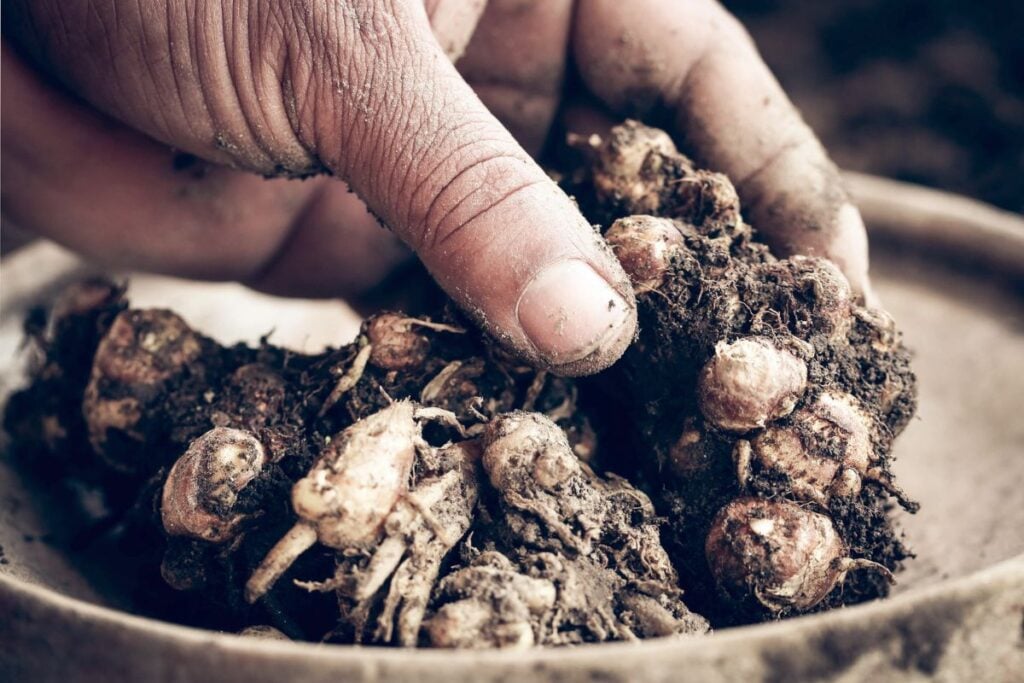
Some diseases were mentioned before, like bacterial wilt, fusarium yellow, dry rot, and rhizome rot.
The only way to save the plant from these diseases is through prevention.
For that:
- Consider crop rotation every 2-3 years.
- Solarise the soil for 40 days before planting.
- Add some lemongrass and mint for the release of essential oils. These oils will kill pathogens.
- If any plant gets infected, immediately discard them to prevent spreading and shift the good plants to other places. Consult a horticulturist and spray some fungicide if needed.
- Plant treated seeds and rhizomes. Soak them in warm water for 1-2 days before planting to eliminate the pathogens.
- Avoid overwatering the plant. Use well-drained soil.
Other diseases are:
Ginger leaf spot
The symptoms of this disease are yellow or white spots over the leaves, around 2-5 cm long.
The center is thin and papery.
Over time, the spot will increase in size.
Rotate crops every 1-2 years.
Avoid high nitrogen fertilizers.
Mosaic virus
The virus creates yellow or dark green mosaic marks all over the leaves.
Over time, the leaves will stop growing, and rhizomes will get infected.
Your rhizomes or seeds might be infected beforehand.
That is why the disease occurred.
Before you plant the rhizomes or seeds, soak them in warm water heated at 113-122°F for 3,6 and 12 hours.
Colletotrichum leaf spot
In this disease, the tips and edges of the leaves have brown marks, and slowly these marks move inwards.
The shapes of the spots are usually spindle-shaped.
Some spots have circular halo with some other colors.
The pathogens remain in the soil over the winter and transfer through water and bugs.
The result of this disease are:
- Poor ginger growth.
- Small rhizomes and lesser in number.
- Leaves die and fail to photosynthesize.
To prevent the disease and manage it:
- Consider crop rotation
- Remove and burn the diseased plant whenever you spot it. There is no treatment.
- Use mild fertilizers in small amounts.
Other ways to control diseases
- Use well-drained soil and avoid prolonged wet conditions.
- Keep the surroundings neat and clean. Remove all debris, old plant materials, and weeds.
- Whenever you use gardening tools, sanitize them before and after usage.
- Use genetically modified ginger variants to prevent such diseases.
Summing up
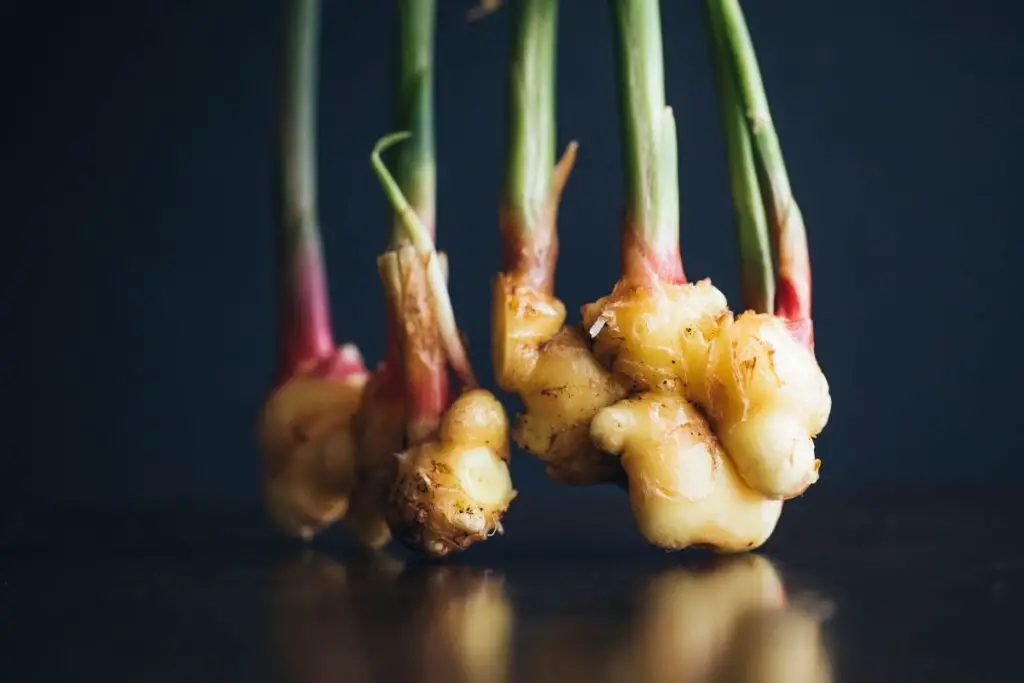
- Plant gingers in the early spring to harvest them before the fall. Plant them 2-4 inches deep and 6-8 inches apart.
- Let gingers have filtered sunlight or partial shade. They hate direct sunlight, but 2-5 hours is fine. Besides, it promotes flowering.
- Plant gingers in well-drained fertile soil. Loam and compost soil are the best types of soil.
- Water the ginger plants regularly, at least once a week. Stop 2-3 weeks before harvesting and completely in winters.
- Feed the plant with a liquid fertilizer (10-20-20 NPK) monthly throughout the summer and spring. Other options are well-aged compost or chicken manure, fish emulsion, and seaweed. Stop it in winters and when the plant flowers.
- Gingers grow best when the air temperature is around 75-85°F, and the soil temperature is 75°F. Protect them from cold winters.
- Ensure they get 70-80% humidity.
- Either harvest ginger 4 months after planting to get ginger greens or 8-10 months after planting to get mature ginger. You can pick up the whole plant. Or, remove some rhizomes and leave the rest in the ground.
Reference: Ginger Production, Texas AgriLife Extension, USDA, Wikipedia
